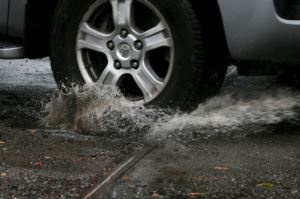 During your commute to work, does it seem like you drive over about 10 potholes each way? While a few of them are small, most of them are quite large and create for a very bumpy and uncomfortable ride to work.
During your commute to work, does it seem like you drive over about 10 potholes each way? While a few of them are small, most of them are quite large and create for a very bumpy and uncomfortable ride to work.
Many potholes are caused when relentless freezing and thawing of water under the pavement weakens the road and causes large cracks, which, when combined with the weight of vehicles driving over, eventually turn into potholes. Because of the role freezing can play in pothole formation, severe winter weather can often lead to lots of potholes. But, as reported by The Mercury News, strong, long-lasting rain storms can also contribute to the number and severity of potholes and even sinkholes.
If you live in a city with lots of potholes, here are a few safety tips from the North Dakota Department of Transportation:
- Properly inflated tires hold up better against potholes than tires that have too much or too little air.
- If you can’t avoid a pothole, slow down before you hit it. But don’t brake directly over a pothole, which can actually cause more damage.
- When driving over the pothole, hold the steering wheel firmly to avoid losing control.
- Use caution when driving over a puddle of water because it might be a pothole in hiding.
After a little research, I found out that potholes can cause serious damage to your car, even if they are small. While you know that running over a large pothole would be bad for your tires, you may not know that some potholes can have as much impact on your car as a 35 mph car crash.
In addition to causing structural damage to the tire itself, potholes may cause additional damage to your tires if they are over- or under-inflated. Potholes may also cause alignment, suspension or steering problems, according to Firestone Complete Auto Care.
So if you’re like us, and have been running over potholes this winter, the Car Care Council says these are some symptoms of pothole damage:
- Bulges or blisters on the tire sidewalls.
- Dents in the wheel rims.
- Undercarriage damage, including fluid leaks and wear that could lead to rust.
- Odd noises coming from the exhaust system due to dents or punctures.
- The car pulling toward the left or right, instead of going straight, which could indicate an alignment problem.
- Uneven tire wear, which could indicate an alignment problem.
If you notice any of these symptoms, you may want to take your car to a repair facility to have it checked for damage by a professional.
TIP: If you encounter a pothole, you should report it to your city, county or state transportation authorities. In some cases, your state, county or city may reimburse you for some of the repair costs.
Source: allstate.com
If you have been injured as a result of poor road maintenance, our firm may be able to help you obtain compensation. Contact Maring Williams Law Office today.
